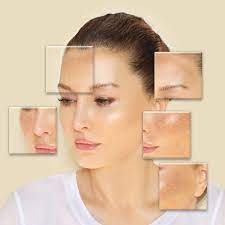Introduction
Post-inflammatory hyperpigmentation (PIH) is a common skin condition characterized by the appearance of dark patches or spots on the skin. It occurs as a result of skin inflammation or injury, leading to an overproduction of melanin, the pigment responsible for skin color. PIH can cause significant distress due to its impact on the skin’s appearance, including skin discoloration, redness on the face, and uneven skin tone. In this article, we will delve into the causes, treatment options, and preventive measures for post-inflammatory hyperpigmentation, empowering you to take control of your skin’s health.
Causes of Post-Inflammatory Hyperpigmentation
Post-inflammatory hyperpigmentation can develop after various types of skin trauma or inflammation, including:
- Acne: Acne breakouts, particularly inflammatory acne, can trigger PIH. When pimples are inflamed, they can cause melanocytes (pigment-producing cells) to produce excess melanin, leading to dark spots once the inflammation subsides.
- Skin injuries: Cuts, burns, abrasions, or any other type of skin injury can result in PIH. Even seemingly minor injuries can disrupt the melanin production process, causing hyperpigmentation.
- Dermatological treatments: Certain dermatological procedures, such as chemical peels, laser treatments, or aggressive exfoliation, can cause temporary skin inflammation and subsequent hyperpigmentation.

Treatment Options for Post-Inflammatory Hyperpigmentation
- Topical Treatments: Over-the-counter creams and serums containing ingredients like hydroquinone, kojic acid, retinoids, or azelaic acid can help lighten and reduce the appearance of dark spots. These ingredients work by inhibiting melanin production and promoting cell turnover. Always consult with a dermatologist before using any new skincare products.
- Chemical Peels: Chemical peels involve the application of a chemical solution to the skin, which exfoliates the top layer, allowing new, fresh skin to emerge. This process can help improve the appearance of PIH by reducing melanin deposits and promoting skin renewal.
- Microdermabrasion: This procedure uses a handheld device to gently exfoliate the skin, removing the top layer and reducing hyperpigmentation. Microdermabrasion can be an effective treatment for mild to moderate PIH.
- Laser Therapy: Certain laser treatments, such as intense pulsed light (IPL) or fractional laser resurfacing, can target pigmented areas and stimulate collagen production, gradually fading dark spots. Laser therapy is generally more effective for deeper or stubborn PIH.
Preventive Measures for Post-Inflammatory Hyperpigmentation
- Sun Protection: Protecting your skin from harmful UV rays is crucial in preventing and minimizing PIH. Always wear broad-spectrum sunscreen with a minimum SPF of 30, even on cloudy days. Additionally, seek shade, wear protective clothing, and use wide-brimmed hats to shield your face from direct sunlight.
- Gentle Skincare Routine: Avoid using harsh or abrasive skincare products that can irritate the skin and trigger inflammation. Instead, opt for gentle cleansers, moisturizers, and exfoliants suited to your skin type. Be consistent with your routine and avoid picking at blemishes or scars to prevent further damage.
- Treat Acne Early: Promptly treating acne breakouts can reduce the risk of developing post-inflammatory hyperpigmentation. Use acne-fighting products containing ingredients like salicylic acid or benzoyl peroxide and consider consulting a dermatologist for personalized acne treatment recommendations.
- Minimize Skin Trauma: Take precautions to minimize skin injuries or trauma. Be gentle when handling your skin, especially during cleansing and exfoliation. Avoid picking at scabs, blemishes, or existing PIH spots, as this can worsen inflammation and increase the risk of hyperpigmentation.
Conclusion
Post-inflammatory hyperpigmentation can be a distressing skin condition, leading to skin discoloration, redness on the face, and an uneven skin tone. However, with proper understanding, treatment, and preventive measures, you can effectively manage and minimize its impact on your skin. Remember to consult a dermatologist for an accurate diagnosis and personalized treatment plan. By embracing a gentle skincare routine, protecting your skin from the sun, and addressing skin inflammation promptly, you can promote a healthier, more even complexion and restore your confidence in your skin’s appearance.
Image Credit: Google
By Bisma Khan
Recommend0 recommendationsPublished in Uncategorized

